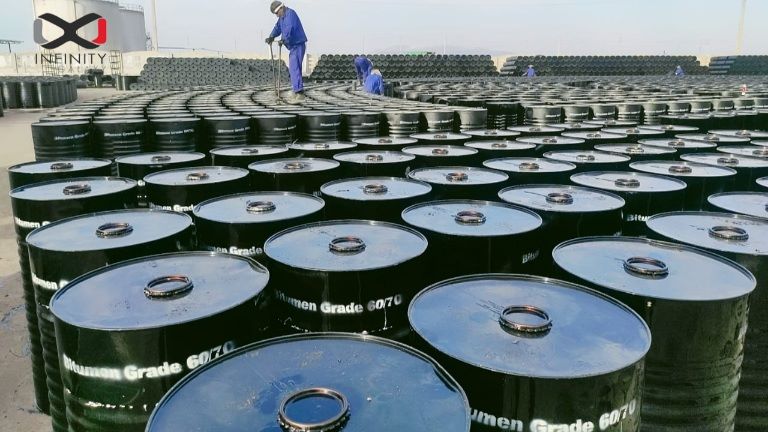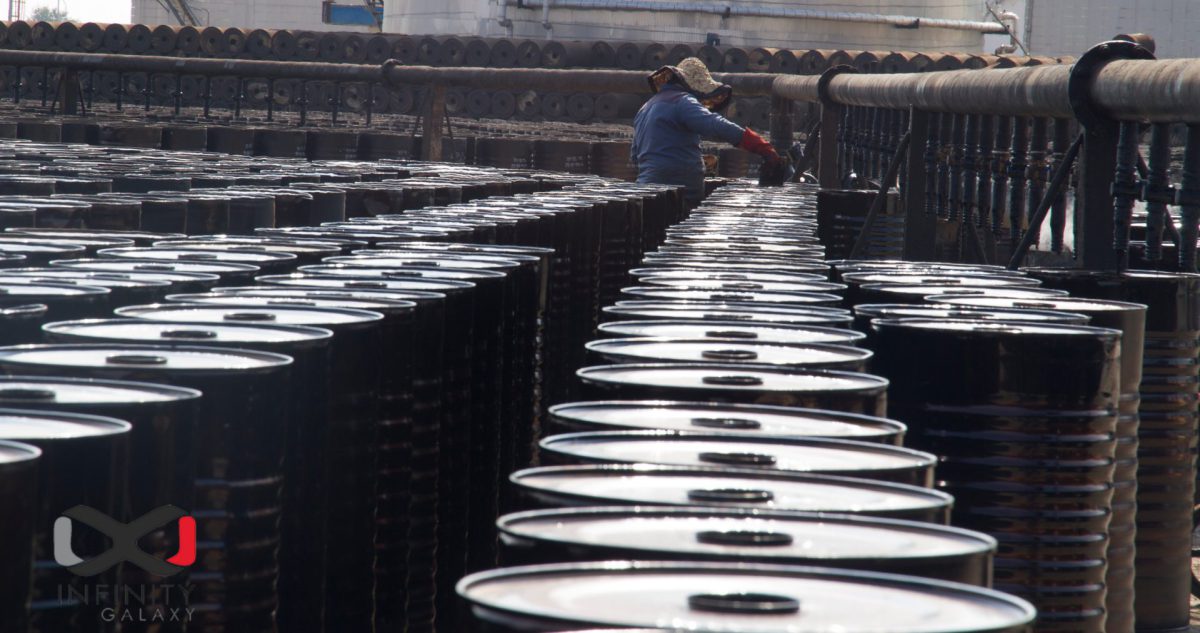Penetration grade bitumen, known also as paving grade bitumen, is unique for road construction in various environmental conditions. These grades of bitumen are named due to their level of hardness and consistency, which leads to the classification of bitumen in a range of grades from 30 to 120.
The main goal for grading bitumen based on penetration is to determine their suitability for use in various construction methods and under different climatic conditions.
Classification of Penetration Grade Bitumen
PEN grades are classified based on the depth into which a certain laboratory needle penetrates them. A penetration test is performed to indicate the hardness of bitumen.
If the achieved figures were high, the tested bitumen is soft. It means that the needle has penetrated in more depth.
On the contrary, lower figures show that the tested bitumen is hard and the penetration depth is shallow. For instance, when we say bitumen 60/70, the first number stands for minimum penetration, and the second one stands for maximum penetration.
The most popular bitumen pen grades include:
- Bitumen 50/70
- Bitumen 60/70
- Bitumen 80/100
- Bitumen 100/120.
Among all penetration grades bitumen, bitumen 85/100 is the softest, and bitumen 40/50 is the hardest one.
Check Out the different grades of bitumen post to learn more about other bitumen grades and types like viscosity grade bitumen and liquid bitumen.
Penetration Grade Bitumen Specifications
Below you can find specification of various types of penetration bitumen:
| Bitumen Penetration Grade 30/40 Specifications | ||||
|---|---|---|---|---|
| Specification | Test Method | Unit | Min. | Max. |
| Specific Gravity at 25 °C | ASTM D70 | – | 1.01 | 1.06 |
| Penetration at 25 °C, 100g, 5s | ASTM D5 | 0.1mm | 30 | 40 |
| Softening Point | ASTM D36 | °C | 51 | 60 |
| Ductility at 25 °C | ASTM D113 | cm | 100 | – |
| Loss on Heating | ASTM D6 | wt.% | – | 0.5 |
| Drop in Penetration after Heating | ASTM D5 | % | – | 20 |
| Flash Point | ASTM D92 | °C | 250 | – |
| Solubility in Trichloroethylene | ASTM D2042 | wt.% | 99.5 | – |
| Spot Test | AASHTO T102 | Negative | ||
| Bitumen Penetration Grade 35/50 Specifications | ||||
|---|---|---|---|---|
| Specification | Test Method | Unit | Min. | Max. |
| Specific Gravity at 25 °C | ASTM D70 | – | 1.01 | 1.06 |
| Penetration at 25 °C, 100g, 5s | ASTM D5 | 0.1mm | 35 | 50 |
| Softening Point | ASTM D36 | °C | 52 | 60 |
| Ductility at 25 °C | ASTM D113 | cm | 100 | – |
| Loss on Heating | ASTM D6 | wt.% | – | 0.2 |
| Drop in Penetration after Heating | ASTM D5 | % | – | 20 |
| Flash Point | ASTM D92 | °C | 250 | – |
| Solubility in Trichloroethylene | ASTM D2042 | wt.% | 99 | – |
| Spot Test | AASHTO T102 | Negative | ||
| Bitumen Penetration Grade 40/50 Specifications | ||||
|---|---|---|---|---|
| Specification | Test Method | Unit | Min. | Max. |
| Specific Gravity at 25 °C | ASTM D70 | – | 1.01 | 1.06 |
| Penetration at 25 °C, 100g, 5s | ASTM D5 | 0.1mm | 40 | 50 |
| Softening Point | ASTM D36 | °C | 52 | 60 |
| Ductility at 25 °C | ASTM D113 | cm | 100 | – |
| Loss on Heating | ASTM D6 | wt.% | – | 0.2 |
| Drop in Penetration after Heating | ASTM D5 | % | – | 20 |
| Flash Point | ASTM D92 | °C | 250 | – |
| Solubility in Trichloroethylene | ASTM D2042 | wt.% | 99 | – |
| Spot Test | AASHTO T102 | Negative | ||
| Bitumen Penetration Grade 50/70 Specifications | ||||
|---|---|---|---|---|
| Specification | Test Method | Unit | Min. | Max. |
| Penetration at 25 °C, 100g, 5s | EN 1426 | 0.1mm | 50 | 70 |
| Softening Point | EN 1427 | °C | 46 | 54 |
| Kinematic Viscosity@135 °C | EN 12595 | CST | 295 | – |
| Penetration Index | EN12591 | mm | -1.5 | + 0.7 |
| Flash Point | EN 2592 | °C | 230 | – |
| Solubility in Toluene or Xylene | EN 12592 | wt.% | 99 | – |
| Spot Test | AASHTO T102 | Negative | ||
| Bitumen Penetration Grade 60/70 Specifications | ||||
|---|---|---|---|---|
| Specification | Test Method | Unit | Min. | Max. |
| Specific Gravity at 25 °C | ASTM D70 | – | 1.01 | 1.06 |
| Penetration at 25 °C, 100g, 5s | ASTM D5 | 0.1mm | 60 | 70 |
| Softening Point | ASTM D36 | °C | 49 | 56 |
| Ductility at 25 °C | ASTM D113 | cm | 100 | – |
| Loss on Heating | ASTM D6 | wt.% | – | 0.2 |
| Drop in Penetration after Heating | ASTM D5 | % | – | 20 |
| Flash Point | ASTM D92 | °C | 250 | – |
| Solubility in Trichloroethylene | ASTM D2042 | wt.% | 99 | – |
| Spot Test | AASHTO T102 | Negative | ||
| Bitumen Penetration Grade 70/100 Specifications | ||||
|---|---|---|---|---|
| Specification | Test Method | Unit | Min. | Max. |
| Specific Gravity at 25 °C | EN 15326 | – | 1.01 | 1.05 |
| Penetration at 25 °C, 100g, 5s | EN 1426 | 0.1mm | 70 | 100 |
| Softening Point | EN 1427 | °C | 43 | 53 |
| Ductility at 25 °C | EN 13589 | cm | 100 | – |
| Loss on Heating | EN 12607 | wt.% | – | 0.5 |
| Flash Point | EN 2592 | °C | 225 | – |
| Solubility in Trichloroethylene | EN 12592 | wt.% | 99 | – |
| Spot Test | AASHTO T102 | Negative | ||
| Bitumen Penetration Grade 80/100 Specifications | ||||
|---|---|---|---|---|
| Specification | Test Method | Unit | Min. | Max. |
| Specific Gravity at 25 °C | ASTM D70 | – | 1.01 | 1.05 |
| Penetration at 25 °C, 100g, 5s | ASTM D5 | 0.1mm | 80 | 100 |
| Softening Point | ASTM D36 | °C | 42 | 52 |
| Ductility at 25 °C | ASTM D113 | cm | 100 | – |
| Loss on Heating | ASTM D6 | wt.% | – | 0.5 |
| Flash Point | ASTM D92 | °C | 225 | – |
| Solubility in Trichloroethylene | ASTM D2042 | wt.% | 99 | – |
| Spot Test | AASHTO T102 | Negative | ||
| Bitumen Penetration Grade 85/100 Specifications | ||||
|---|---|---|---|---|
| Specification | Test Method | Unit | Min. | Max. |
| Specific Gravity at 25 °C | ASTM D70 | – | 1.01 | 1.05 |
| Penetration at 25 °C, 100g, 5s | ASTM D5 | 0.1mm | 85 | 100 |
| Softening Point | ASTM D36 | °C | 42 | 52 |
| Ductility at 25 °C | ASTM D113 | cm | 100 | – |
| Loss on Heating | ASTM D6 | wt.% | – | 0.5 |
| Flash Point | ASTM D92 | °C | 225 | – |
| Solubility in Trichloroethylene | ASTM D2042 | wt.% | 99 | – |
| Spot Test | AASHTO T102 | Negative | ||
| Bitumen Penetration Grade 100/120 Specifications | ||||
|---|---|---|---|---|
| Specification | Test Method | Unit | Min. | Max. |
| Specific Gravity at 25 °C | ASTM D70 | – | 1.01 | 1.04 |
| Penetration at 25 °C, 100g, 5s | ASTM D5 | 0.1mm | 100 | 120 |
| Softening Point | ASTM D36 | °C | 42 | 49 |
| Ductility at 25 °C | ASTM D113 | cm | 100 | – |
| Loss on Heating | ASTM D6 | wt.% | – | 0.2 |
| Flash Point | ASTM D92 | °C | – | 250 |
| Solubility in Trichloroethylene | ASTM D2042 | wt.% | – | 99.5 |
| Spot Test | AASHTO T102 | Negative | ||
| Bitumen Penetration Grade 200/300 Specifications | |||||
|---|---|---|---|---|---|
| Specification | Test Method | Unit | Min. | Max. | |
| Specific Gravity at 25 °C | ASTM D70 | – | 1.01 | 1.06 | |
| Penetration at 25 °C | ASTM D5 | 0.1mm | 200 | 300 | |
| Softening Point | ASTM D36 | °C | 35 | 43 | |
| Ductility at 25 °C | ASTM D113 | cm | 100 | – | |
| Flash Point | ASTM D92 | °C | 230 | – | |
| Solubility in Trichloroethylene | ASTM D2024 | wt.% | 99 | – | |
| After Thin Film Oven Test (TFOT) | |||||
| Penetration | ASTM D2872 | 46 | – | ||
| Change of Mass | ASTM D2872 | wt.% | – | 0.8 | |
| Softening Point | ASTM D2872 | – | 11 | ||
| Bitumen Penetration Grade 100/130 Specifications | ||||
|---|---|---|---|---|
| Specification | Test Method | Unit | Min. | Max. |
| Specific Gravity at 25 °C | ASTM D70 | – | 1.01 | 1.04 |
| Penetration at 25 °C, 100g, 5s | ASTM D5 | 0.1mm | 100 | 130 |
| Softening Point | ASTM D36 | °C | 42 | 49 |
| Ductility at 25 °C | ASTM D113 | cm | 100 | – |
| Loss on Heating | ASTM D6 | wt.% | – | 0.2 |
| Flash Point | ASTM D92 | °C | – | 250 |
| Solubility in Trichloroethylene | ASTM D2042 | %WT | – | 99.5 |
| Spot Test | AASHTO T102 | Negative | ||
Penetration Grade Bitumen Uses
Bitumen penetration grades are mainly used in the manufacturing of hot mix asphalt for road base and wearing courses.
Read the article about different types of bitumen that can be used in road construction to know more about types of bitumen that can be used in prime coat, tack coat and other layers.
To choose among various grades of bitumen penetration, many factors should be taken into account, including, the average temperature of the region, the level of traffic loads, and the type of soil.
The higher the penetration grade, the softer the bitumen. So 80/100 is much softer than 40/50. Soft bitumen is more suitable for soils with high particle density such as clay. On the other hand, high penetration graded bitumen works better for soils with low particle density. For applications requiring higher viscosity, we offer viscosity grade bitumen.
Air temperature is another crucial factor in selecting penetration grade. If you are paving a road in a very cold or even hot region, be careful. If the bitumen is too soft or hard in the environment temperature, the possibility of cracking or deformation increases.
Therefore, soft bitumen performs better in cold climates and hard bitumen works better in hot climates.
Considering the traffic load is also necessary when it comes to penetration grades. Softer grades like 60/70 show more durability exposing to heavy traffic loads. Accordingly, lower grades are used for paving roads with high traffic loads.
Before using penetration grade bitumen, pay attention to test results and other factors such as penetration grade, flash point, softening point, ductility, and specific gravity.







